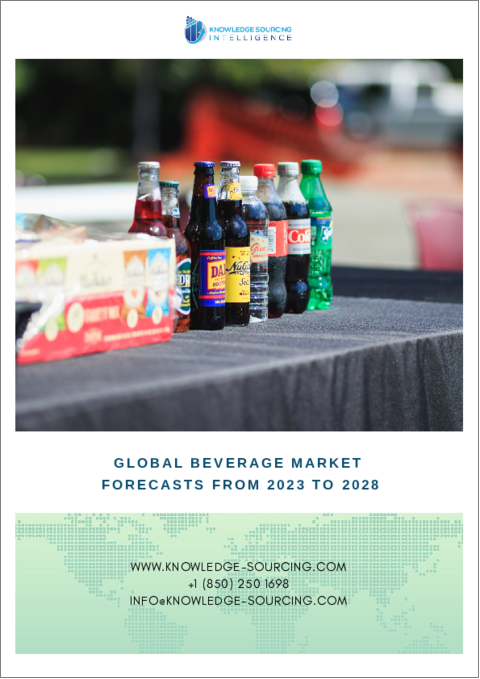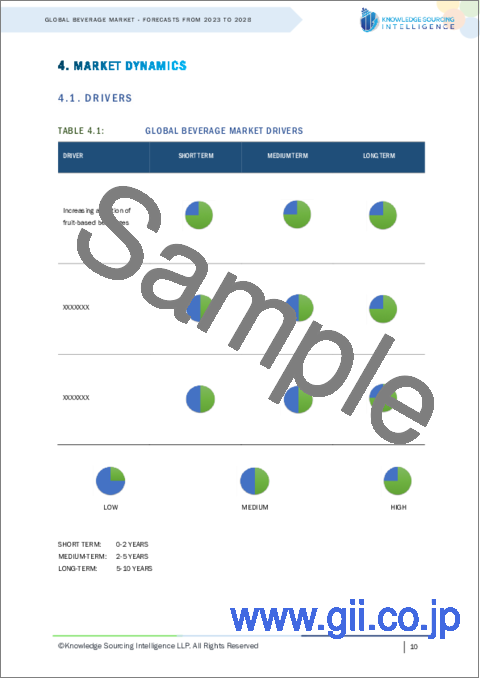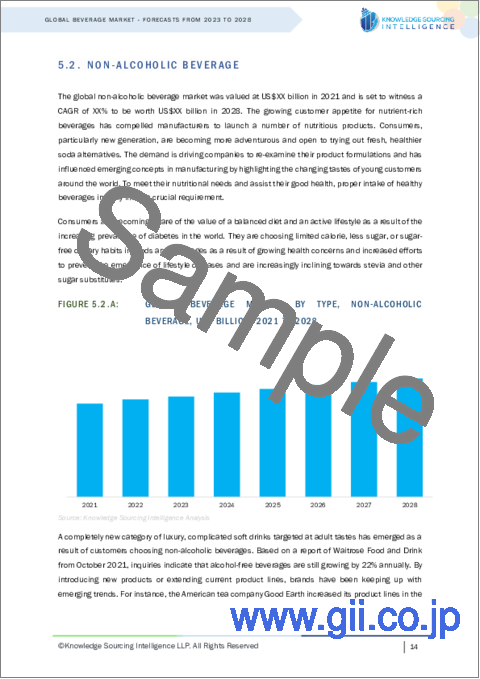|
|
市場調査レポート
商品コード
1256582
飲料の世界市場-2023年から2028年までの予測Global Beverage Market - Forecasts from 2023 to 2028 |
||||||
|
● お客様のご希望に応じて、既存データの加工や未掲載情報(例:国別セグメント)の追加などの対応が可能です。 詳細はお問い合わせください。 |
|||||||
| 飲料の世界市場-2023年から2028年までの予測 |
|
出版日: 2023年03月30日
発行: Knowledge Sourcing Intelligence
ページ情報: 英文 210 Pages
納期: 即日から翌営業日
|
- 全表示
- 概要
- 目次
飲料の世界市場は、2021年の初期値1兆5,683億8,900万米ドルからCAGR3.47%で成長し、2028年には1兆9,918億4,500万米ドルの市場規模に達すると予測されます。
可処分所得の増加や、特に新興経済諸国における、すぐに飲める飲料への消費者の嗜好の変化により、予測期間中、市場は適正な速度で成長すると予測されます。さらに、一人当たりのアルコール飲料消費量の増加や、プレミアム製品への消費者の嗜好が、市場拡大の原動力となりそうです。例えば、エストニア社会省によると、エストニア国民は2021年に成人(15歳以上)人口1人当たり平均11.1リットルの絶対的アルコールを消費し、前年比2.3%増となりました。消費量の増加は、主にウィスキー、ジン、リキュールなどの強いアルコール飲料の消費が増加したことと、ビール、ワインなどの穏やかなアルコールの消費がわずかに増加したことによるものです。
しかし、パッケージ飲料に含まれる糖分に対する健康上の懸念が高まり、アルコール使用に対する健康上の懸念と相まって、予測期間中の市場拡大が阻害される可能性があります。しかし、ノンアルコール飲料の分野では、より低糖度の飲料など、新製品が投入されることで、予測期間中およびそれ以降、市場にいくつかの機会が生まれると予想されます。例えば、Coca-Cola India社は、今後2年間で同社のスパークリングブランドに低糖とゼロ糖のバリエーションを提供する計画を発表し、急成長する低糖飲料カテゴリーに大きな賭けをしました。また、飲料会社は、ボトリングパートナー各社が生産拡大に約10億米ドルを投資していると述べています。ブドウ糖と電解質を含むLimca Sportzは、同社の広範な水分補給戦略の一環として、2022年8月に発売されました。
飲料の世界市場は、フルーツベースの飲料の採用が進んでいることが要因
より健康的な内容で果物をベースとしたものなど、新しいノンアルコール製品の導入は、予測期間中およびそれ以降、市場にいくつかのチャンスを生み出すと予想されます。Eurostatによると、EUでは2019年に成人(15歳以上)の9%が砂糖入り清涼飲料水を毎日飲み、6%が週に4~6回飲み、19%が週に1回以下飲んでいます。砂糖入り飲料の定期的な摂取は、心臓病、2型糖尿病、腎臓病、虫歯、関節炎の一種である痛風、虫歯、非アルコール性肝疾患と関係があると言われています。パッケージ飲料の糖度やアルコール摂取に対する健康上の懸念が高まっているため、最終的には糖分を抑えたフルーツ系飲料の需要が高まる可能性があります。例えば、ベレゾフスキーは2022年8月に数百万米ドルの契約を結び、イスラエルの小さなスタートアップであるBlueTree Technologies社製の1億リットルのジュースを流通させました。この会社は最先端の技術を使って、風味に影響を与えずに自然に絞ったオレンジジュースから最大50%の砂糖を簡単に取り除くことができます。キリヤット・シュモナのフレッシュ・スタートでは、BlueTree社が1日最大50リットルの生産が可能なプロトタイプを稼働させています。また、BlueTree社の製品を様々な世界企業に売り込むため、イスラエルの清涼飲料メーカーPriniv社と契約を結び、世界なジュース・飲料メーカーとの契約も控えています。
飲料の世界市場では、北米が大きなシェアを占める
地域別に見ると、飲料市場は北米、南米、欧州、中東・アフリカ、アジア太平洋に分類されます。北米は、米国、カナダ、メキシコにさらに分類されます。この地域は、健康とウェルネスに対する意識の高まりと、より健康的でプレミアムな飲料を求める消費者により、飲料の重要な市場となっています。米国では、植物性ミルク、エナジードリンク、機能性飲料、無糖飲料など、より健康的で持続可能な飲料オプションへの傾向が高まっており、便利で外出先での飲料オプションへの需要が高まっていることが予測期間中の市場成長を促進すると予想されます。例えば、2021年3月、リンゴ酢製品のメーカーとして知られるBragg Live Food Productsとガラス容器の大手メーカーであるArdagh Groupは、リンゴ酢飲料のラインアップに新しい16オンスガラスボトルを導入する提携を発表しました。
目次
第1章 イントロダクション
- 市場概要
- 市場の定義
- 調査範囲
- 市場セグメンテーション
- 通貨
- 前提条件
- 基準年と予測年のタイムライン
第2章 調査手法
- 調査データ
- 調査デザイン
第3章 エグゼクティブサマリー
- 調査ハイライト
第4章 市場力学
- 市場促進要因
- 市場抑制要因
- ポーターのファイブフォース分析
- 業界バリューチェーン分析
第5章 飲料の世界市場:タイプ別
- イントロダクション
- アルコール飲料
- ノンアルコール飲料
- ボトルウォーター
- 炭酸飲料
- フルーツジュース
- 牛乳
第6章 飲料の世界市場:包装タイプ別
- イントロダクション
- 缶
- ボトル
- その他
第7章 飲料の世界市場:流通チャネル別
- イントロダクション
- オンライン
- オフライン
- スーパーマーケット
- デパート
- コンビニエンスストアと個人店
- 食品サービス
第8章 飲料の世界市場:地域別
- イントロダクション
- 北米
- 米国
- カナダ
- メキシコ
- 南米
- ブラジル
- アルゼンチン
- その他
- 欧州
- 英国
- ドイツ
- フランス
- イタリア
- その他
- 中東・アフリカ
- サウジアラビア
- アラブ首長国連邦
- その他
- アジア太平洋
- 中国
- 日本
- インド
- 韓国
- 台湾
- タイ
- インドネシア
- その他
第9章 競合環境と分析
- 主要企業と戦略分析
- 新興企業と市場収益性
- 合併、買収、合意およびコラボレーション
- ベンダー競争力マトリックス
第10章 企業プロファイル
- Unilever
- The Coca-Cola Company
- Nestle
- Pepsi Co Inc
- Jones Soda Co.
- Danone
- Appalachia Brewing Company
- GCMMF(Amul)
- Keurig Dr Pepper Inc.
- Bacardi Limited
- Carlsberg Breweries A/S
- Heineken N.V.
- Suntory Holdings Limited
- Constellation Brands Inc.
- Molson Coors Brewing Company
- United Breweries Group
- Brown-Forman Corporation
The global beverage market is expected to grow at a CAGR of 3.47% from an initial value of US$1,568.389 billion in 2021 and is estimated to reach a market size of US$1,991.845 billion in 2028.
Due to increasing disposable income, and shifting consumer preferences towards ready-to-drink beverages, particularly in developing and emerging economies, the market is anticipated to grow at a fair rate throughout the forecast period. Furthermore, rising per capita consumption of alcoholic beverages and consumer preferences for premium products are likely to fuel market expansion. For instance, according to the Estonian Ministry of Social Affairs, the Estonian people consumed an average of 11.1 liters of absolute alcohol per adult (15+) population in 2021, a 2.3% increase from the previous year. The increase in consumption was primarily due to an increase in consumption of strong alcoholic beverages such as whisky, gin, and liqueur, as well as a slight increase in consumption of beer, wine, and other mild alcohol.
However, increased health concerns about the sugar content of packaged beverages, combined with health worries about alcohol usage, may stymie market expansion during the projection period. However, the introduction of new products in the non-alcoholic segment, such as drinks with lower sugar content, is expected to generate several opportunities for the market during the projection period and beyond. For instance, Coca-Cola India announced plans to offer low and zero-sugar variations of its sparkling brands over the next two years, betting big on the fast-growing reduced sugar beverage category. The beverage company also stated that its bottling partners are investing approximately $1 billion in production growth. Limca Sportz, which contains glucose and electrolytes, was launched in August 2022 as part of the company's broader hydration strategy.
The global beverage market is driven by the increasing adoption of fruit-based beverages.
The introduction of new non-alcoholic products, such as those with healthier content and based on fruits, is expected to generate several chances for the market during the projection period and beyond. According to Eurostat, in the EU, 9% of adults (15 and older) drank sugar-sweetened soft drinks every day in 2019, 6% did so four to six times per week, and 19% did so once or less per week. Regular intake of sugar-sweetened beverages has been related to heart disease, type 2 diabetes, kidney illness, cavities, gout, a form of arthritis, tooth decay, and non-alcoholic liver disease. The demand for fruit-based beverages with reduced sugar content may eventually increase due to growing health concerns about the sugar level of packaged beverages and alcohol consumption. For instance, Berezovsky signed a multi-million-dollar agreement in August 2022 to distribute 100 million liters of juice made by BlueTree Technologies, a small Israeli startup that uses cutting-edge technology to simply remove up to 50% of the sugar from naturally squeezed orange juice without affecting the flavor. At Fresh Start in Kiryat Shmona, BlueTree is operating its prototype, which can produce up to 50 liters per day. To promote BlueTree's products to various global companies, the business has also struck a contract with the Israeli soft drink manufacturer Priniv and is about to do the same with a global juice and beverage manufacturer.
Key Developments
- Tata Consumer Products (TCPL) has joined the fruit-based drinks sector with the November 2022 launch of Fruski Juice N Jelly drink through its subsidiary NourishCo. The new introduction is in keeping with NourishCo's goal of expanding its product portfolio and becoming a prominent player in the non-alcoholic beverages category. India's ready-to-drink sector is greatly underserved. Unbranded juices and ethnic beverages dominate the market. The corporation identified enormous potential in this area and intends to enter the juices and ethnic beverages space with the Tata Fruski brand.
- In December 2022, Fresh Del Monte debuted a line of energy drinks in conjunction with Scotland-based beverage maker, Old Tom Gin. The beverages in the 'A Kick of Fruit' line include at least 20% actual fruit juice and no added sugar.
- In January 2022, Danone North America, the maker of Silk plant-based products, added Silk Extra Creamy Almond milk to its portfolio of alternative dairy products which is also a good source of vitamins and minerals, and is free from dairy, soy, and gluten, making it a suitable choice for people with food sensitivities.
North America accounts for major shares of the global beverage market.
By geography, the beverage market has been segmented into North America, South America, Europe, the Middle East and Africa, and the Asia Pacific. North America has been further classified into US, Canada, and Mexico. The region is a significant market for beverages due to growing awareness of health and wellness, and consumers seeking healthier and more premium beverage options. In the United States, there is a growing trend towards healthier and more sustainable beverage options like plant-based milk, energy drinks, functional beverages, and sugar-free drinks with the increasing demand for convenient and on-the-go beverage options that are expected to drive the market growth over the forecast period. For instance, In March 2021, Bragg Live Food Products, a well-known producer of apple cider vinegar products, and Ardagh Group, a leading producer of glass containers, announced a partnership to introduce a new 16oz glass bottle for its line of apple cider vinegar beverages.
Market Segmentation
By Type
- Alcoholic Beverage
- Non-Alcoholic Beverage
- Bottled Water
- Carbonated Soft Drinks
- Fruit Juice
- Milk
- Dairy
- Almond
- Soy
- Rice
- Oat
- Cashew
- Coconut
- Others
By Packaging Type
- Cans
- Bottles
- Others
By Distribution Channel
- Online
- Offline
- Supermarkets
- Departmental Stores
- Convenience and Independent Stores
- Foodservice
By Geography
- North America
- USA
- Canada
- Mexico
- South America
- Brazil
- Argentina
- Others
- Europe
- UK
- Germany
- France
- Italy
- Others
- Middle East and Africa
- Saudi Arabia
- UAE
- Others
- Asia Pacific
- China
- Japan
- India
- South Korea
- Taiwan
- Thailand
- Indonesia
- Others
TABLE OF CONTENTS
1. INTRODUCTION
- 1.1. Market Overview
- 1.2. Market Definition
- 1.3. Scope of the Study
- 1.4. Market Segmentation
- 1.5. Currency
- 1.6. Assumptions
- 1.7. Base and Forecast Years Timeline
2. RESEARCH METHODOLOGY
- 2.1. Research Data
- 2.2. Research Design
3. EXECUTIVE SUMMARY
- 3.1. Research Highlights
4. MARKET DYNAMICS
- 4.1. Market Drivers
- 4.2. Market Restraints
- 4.3. Porter's Five Force Analysis
- 4.3.1. Bargaining Power of Suppliers
- 4.3.2. Bargaining Power of Buyers
- 4.3.3. Threat of New Entrants
- 4.3.4. Threat of Substitutes
- 4.3.5. Competitive Rivalry in the Industry
- 4.4. Industry Value Chain Analysis
5. GLOBAL BEVERAGE MARKET, BY TYPE
- 5.1. Introduction
- 5.2. Alcoholic Beverage
- 5.3. Non-Alcoholic Beverage
- 5.3.1. Bottled Water
- 5.3.2. Carbonated Soft Drinks
- 5.3.3. Fruit Juice
- 5.3.4. Milk
- 5.3.4.1. Dairy
- 5.3.4.2. Almond
- 5.3.4.3. Soy
- 5.3.4.4. Rice
- 5.3.4.5. Oat
- 5.3.4.6. Cashew
- 5.3.4.7. Coconut
- 5.3.4.8. Others
6. GLOBAL BEVERAGE MARKET, BY PACKAGING TYPE
- 6.1. Introduction
- 6.2. Cans
- 6.3. Bottles
- 6.4. Others
7. GLOBAL BEVERAGE MARKET, BY DISTRIBUTION CHANNEL
- 7.1. Introduction
- 7.2. Online
- 7.3. Offline
- 7.3.1. Supermarkets
- 7.3.2. Departmental Stores
- 7.3.3. Convenience and Independent Stores
- 7.3.4. Foodservice
8. GLOBAL BEVERAGE MARKET, BY GEOGRAPHY
- 8.1. Introduction
- 8.2. North America
- 8.2.1. USA
- 8.2.2. Canada
- 8.2.3. Mexico
- 8.3. South America
- 8.3.1. Brazil
- 8.3.2. Argentina
- 8.3.3. Others
- 8.4. Europe
- 8.4.1. UK
- 8.4.2. Germany
- 8.4.3. France
- 8.4.4. Italy
- 8.4.5. Others
- 8.5. Middle East and Africa
- 8.5.1. Saudi Arabia
- 8.5.2. UAE
- 8.5.3. Others
- 8.6. Asia Pacific
- 8.6.1. China
- 8.6.2. Japan
- 8.6.3. India
- 8.6.4. South Korea
- 8.6.5. Taiwan
- 8.6.6. Thailand
- 8.6.7. Indonesia
- 8.6.8. Others
9. COMPETITIVE ENVIRONMENT AND ANALYSIS
- 9.1. Major Players and Strategy Analysis
- 9.2. Emerging Players and Market Lucrativeness
- 9.3. Mergers, Acquisitions, Agreements, and Collaborations
- 9.4. Vendor Competitiveness Matrix
10. COMPANY PROFILES
- 10.1. Unilever
- 10.2. The Coca-Cola Company
- 10.3. Nestle
- 10.4. Pepsi Co Inc
- 10.5. Jones Soda Co.
- 10.6. Danone
- 10.7. Appalachia Brewing Company
- 10.8. GCMMF (Amul)
- 10.9. Keurig Dr Pepper Inc.
- 10.10. Bacardi Limited
- 10.11. Carlsberg Breweries A/S
- 10.12. Heineken N.V.
- 10.13. Suntory Holdings Limited
- 10.14. Constellation Brands Inc.
- 10.15. Molson Coors Brewing Company
- 10.16. United Breweries Group
- 10.17. Brown-Forman Corporation




